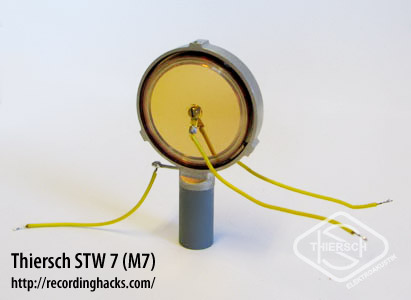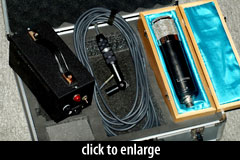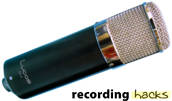 Lucas Engineering CS-4
Lucas Engineering CS-4
Multi-Pattern Tube Condenser Microphone
The CS-4 is a multipattern tube condenser designed by Oliver Archut and Terry Manning as a contemporary reinterpretation of the “sonically colored” family of microphones descended from the Neumann U-47. The mic is emphatically not presented as a U-47 clone, soundalike, or replacement, but rather as a high-end tube mic that the original Neumann engineers might build today.
 The capsule is a PVC-membrane M7, designed and manufactured to match the original Neumann blueprints by former Neumann capsule technician Sigfried Thiersch. Although Thiersch supplies both PVC and Mylar-skinned M7s to numerous manufacturers, the CS-4 capsules are unique in two respects:
The capsule is a PVC-membrane M7, designed and manufactured to match the original Neumann blueprints by former Neumann capsule technician Sigfried Thiersch. Although Thiersch supplies both PVC and Mylar-skinned M7s to numerous manufacturers, the CS-4 capsules are unique in two respects:
- The diaphragms are treated with a moisture repellent to improve performance when close-miking vocals.
- The PVC diaphragm material is aged to meet the NWDR (Nordwestdeutscher Rundfunk) specifications for the Neumann M 49, to ensure the most consistent front-to-back response.
 The Thiersch M7, aka the STW7, has a 32mm (OD) backplate. The membranes are made of ~6-micron PVC; the active area of the diaphragm is 25mm.
The Thiersch M7, aka the STW7, has a 32mm (OD) backplate. The membranes are made of ~6-micron PVC; the active area of the diaphragm is 25mm.
A rotary switch on the power supply provides 11 discrete polar patterns: figure-of-8, Cardioid, and Omni, with four intermediate (hypercardioid-ish) patterns between Cardioid and Fig-8, and four intermediate (subcardioid-ish) patterns between Cardioid and Omni.
Like the CS-1, U-47, and the Bock Audio 251, the capsule’s rear diaphragm is disconnected from the circuit when the mic is set to Cardioid. This “true Cardioid” mode is said to have a higher signal-to-noise ratio than if both diaphragms were active. It also has higher sensitivity, by about 3dB, than do other patterns. (This was also true of the U-47.)
The mic’s tube is a vintage glass pentode manufactured in Germany by Telefunken. Lucas describes it as “technically identical to, and … very similar in sonic character to, the [U 47’s] VF-14.”
Through Oliver Archut’s connections with former microphone and tube engineers in Germany, Lucas has been successful at locating “forgotten” caches of audio tubes — first the 7000 Mullard 6072a-like dual-triodes used in the CS1, and more recently, several thousand of the glass VF14-like Telefunken tubes used in the CS4.
Lucas Engineering expects to maintain a supply of replacement tubes for registered CS-4 owners for the forseeable future.
The transformer in the CS-4 is manufactured by AMI/Tab-Funkenwerk. It is a version of the company’s BV8, fine-tuned for this specific microphone.
 The prototype mic’s headbasket was fabricated by hand from three layers of brass mesh by Oliver Archut, then plated for display at the AES-NYC show in late 2009.
The prototype mic’s headbasket was fabricated by hand from three layers of brass mesh by Oliver Archut, then plated for display at the AES-NYC show in late 2009.
As with the CS-1, the body of the CS-4 is a steel tube finished in the “Lucazite™” process by Jeff Roberts at Latch Lake Products. The physical dimensions of the mic, roughly 63mm x 240mm, match the “long body” style of the U-47.
 A maximum of 300 CS-4s will be made. The first units are expected to ship by late Spring 2010.
A maximum of 300 CS-4s will be made. The first units are expected to ship by late Spring 2010.
Additional specifications for this mic are forthcoming.
Permalink: Lucas Engineering CS-4
The mic was released in 2010.
Specifications
| Pickup Patterns | Pads & Filters |
|---|---|
|
|
| Capsule Dimensions | Impedance | SPL/Noise |
|---|---|---|
| Diaphragm diameter: 25mm Capsule diameter: 32mm Diaphragm gauge: 6 microns |
n/a |
| Weight | Length | Max Diameter | Interface(s) |
|---|---|---|---|
| 956g (33.72oz) | 240mm (9.45'') | 63mm (2.48'') |
|
| Power Specifications |
|---|
|
Did we get anything wrong on this page? Please let us know!


